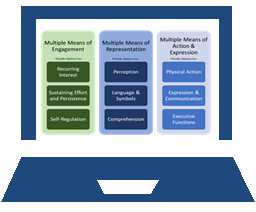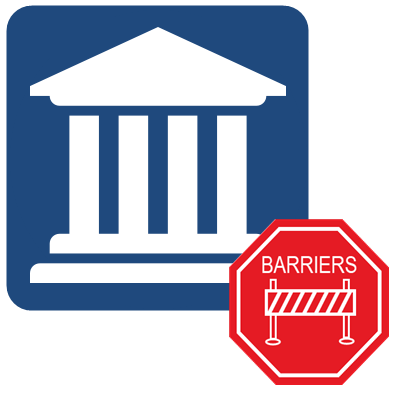Creating Culturally Responsive and Accessible Learning Environments for Racialized Students in Higher Education
Lennique Bannister
Introduction
Racialized students in higher education often navigate learning environments that were not designed with their cultural identities, histories, and needs in mind. Many post-secondary institutions, despite public commitments to diversity, equity, and inclusion, continue to center Eurocentric knowledge and teaching practices that alienate students of color, perpetuate systemic inequities, and hinder academic success. The inequities are further amplified by physical pedagogical barriers that overlook students’ accessibility requirements and culturally grounded ways of knowing, creating a disconnect between students’ lived experiences and their educational journeys. In this chapter, I will be arguing that developing culturally responsive and accessible learning environments is essential for improving equity and academic success for racialized students in higher education.
Conceptual and Theoretical Frameworks
![]() Sociocultural theory, developed by Vygotsky (1978), emphasizes that learning is inherently shaped by social and cultural intentions. According to this view, students construct knowledge through collaborative processes that reflect their diverse cultural, linguistic, and historical experiences. I noticed that Culturally Responsive Teaching (CRT) builds on sociocultural foundations by asserting that educators must recognize and draw upon students’ cultural identities to make learning more meaningful and empowering (Ladson-Billings, 1995)! In practice, CRT validates the cultural assets of racialized students and integrates their lived experiences into curriculum and pedagogy to enhance engagement and academic achievement.
Sociocultural theory, developed by Vygotsky (1978), emphasizes that learning is inherently shaped by social and cultural intentions. According to this view, students construct knowledge through collaborative processes that reflect their diverse cultural, linguistic, and historical experiences. I noticed that Culturally Responsive Teaching (CRT) builds on sociocultural foundations by asserting that educators must recognize and draw upon students’ cultural identities to make learning more meaningful and empowering (Ladson-Billings, 1995)! In practice, CRT validates the cultural assets of racialized students and integrates their lived experiences into curriculum and pedagogy to enhance engagement and academic achievement.
When we think about accessibility in higher education, it is important to recognize that it’s not just about removing physical or technical obstacles; it also means creating learning spaces that reflect, respect and respond to students’ identities and cultural knowledge. In other words, a truly accessible and inclusive environment must address these deeper cultural and institutional patterns so that all students, especially those from racialized backgrounds, can fully participate and feel they truly belong. Together, these barriers highlight the urgent need for culturally responsive and accessible learning environments that recognize racialized students’ strengths and challenge systemic inequities.
Both of these examples highlight the importance of tailored, culturally responsive support. Whether it’s Indigenous students seeing their knowledge centered in curricula or racialized students receiving specialized mentoring, these initiatives make a powerful difference. They show that when Universities try to recognize and respond to diverse students’ identities and needs, students are more likely to persist and graduate. We can’t go back in time, but had my university shown this same initiative, my experience would’ve been different. The thing is, if you were to ask most of the racialized students about their experiences, they would share similar feelings. Going forward, it is this commitment to genuine inclusion, making every student feel seen, supported, and valued, that will truly transform higher education for everyone!
 Universal Design for Learning (UDL) is an educational framework that proactively designs curricula and instruction to minimize barriers for all students and optimize learning through flexible and inclusive practices (CAST, 2018). Grounded in research on the neuroscience of learning, UDL principles emphasize multiple means of representation, like offering information in diverse formats, engagement, like supporting different interests and motivations, and action/expression, like providing diverse ways to demonstrate learning (CAST, 2018). I used to think brain science had nothing to do with education. I’ve come to see how neuroscience is shaping learning technologies and educational practices in powerful ways. I like the flexibility and accessibility UDL emphasizes to ensure that racialized students, as well as those who may face additional barriers related to disability, language, or socioeconomic status, can fully participate and succeed.
Universal Design for Learning (UDL) is an educational framework that proactively designs curricula and instruction to minimize barriers for all students and optimize learning through flexible and inclusive practices (CAST, 2018). Grounded in research on the neuroscience of learning, UDL principles emphasize multiple means of representation, like offering information in diverse formats, engagement, like supporting different interests and motivations, and action/expression, like providing diverse ways to demonstrate learning (CAST, 2018). I used to think brain science had nothing to do with education. I’ve come to see how neuroscience is shaping learning technologies and educational practices in powerful ways. I like the flexibility and accessibility UDL emphasizes to ensure that racialized students, as well as those who may face additional barriers related to disability, language, or socioeconomic status, can fully participate and succeed.
Critical Race Theory (CRT) underscores that systemic racism is embedded in educational structures, policies, and practices and that the counter-stories of racialized students offer valuable insights into transforming these systems. Using CRT in higher education helps educators reject negative stereotypes and recognize how racism within institutions keeps unfairness in place. The funds of knowledge framework (Moll et al., 1992) goes hand-in-hand with CRT by reminding me that my students have already come to class with rich cultural knowledge and experiences. Recognizing and valuing what they bring into our learning space helps me connect lessons to their lives and make learning more meaningful.
Drawing on funds of knowledge reminds me to see my students’ home and community experiences as valuable resources for learning. I feel like when I do this, I’m putting sociocultural and UDL principles into practice, creating more inclusive and accessible classrooms (Moll et al., 1992). Together, CRT and the funds of knowledge framework inspire me to design learning environments that build on racialized students’ strengths, challenge systemic inequities, and help every student feel like they truly belong.
Barriers for Racialized Students in Higher Education
 Many racialized students in higher education report feeling excluded from academic spaces where they rarely see their identities reflected in the curriculum, teaching practices, or leadership. I felt this personally as a Black Caribbean woman from The Bahamas who came to Canada at 18. I had grown up surrounded by people who looked like me and shared my cultural background, so stepping into a predominantly white university was an unfamiliar and often isolating experience.
Many racialized students in higher education report feeling excluded from academic spaces where they rarely see their identities reflected in the curriculum, teaching practices, or leadership. I felt this personally as a Black Caribbean woman from The Bahamas who came to Canada at 18. I had grown up surrounded by people who looked like me and shared my cultural background, so stepping into a predominantly white university was an unfamiliar and often isolating experience.
Research by Museus and Paulsen (2014) also shows that when racialized students rarely encounter mentors or role models who share their background, they are more likely to feel that they do not belong. This is so true because I studied at my university for six years, and it was not until I pursued my second degree that I finally connected with a role model who was also Black. It was a breath of fresh air to have that experience! Although it happened late, I was happy to get that experience altogether. Some racialized people don’t get this experience at all, and the absence of representation can make it difficult for students to envision themselves succeeding in higher education.
The dominance of Eurocentric curricula further alienates racialized students, who rarely see their histories, languages, or ways of knowing represented in their classes (Ladson-Billings, 1995). When the material celebrates cultural perspectives as the norm, students may feel that their identities and knowledge are devalued. This problem is due to the lack of diverse faculty and leadership in higher ed. Without professors and mentors who share similar cultural or racial experiences, students often struggle to envision themselves as scholars or feel unsupported in their academic pursuits.
The concept of Intersectionality should remind us that racialized students do not all face the same challenges. What I mean by this is that there are other factors to consider besides race, such as gender, socioeconomic background, language, and even immigration status, which can change the kinds of barriers they face. To further break this down, if we consider a racialized student who is also the first in their family to attend college, for example, they may lack both financial resources and social capital. Similarly, a racialized student with a disability may face additional stigma or inadequate accessibility supports. These intersecting identities can amplify exclusion and make it even more difficult for students to navigate higher education successfully (Museus et al., 2017). Recognizing this reminds me to see students as whole people with unique stories, rather than assuming they all need the same kind of support. I keep this mindset when working with my little ones because when they get older and if they do decide to go into Higher Ed, they would’ve already developed confidence in their identities and strengths. They’re more prepared to navigate diverse environments, advocate for themselves, and see resources that match their unique backgrounds.
These barriers took me back to one of my first courses in this program, where we read “Whistling Vivaldi” by Claude M. Steele (2011). Steele’s main goal in this book was not simply to demonstrate the power of stereotype threat, but to reveal just how subtle and often invisible it is in everyday life. Throughout the book, Steele illustrates how these stereotypes profoundly shape the university experience for racialized students. One part that stayed with me was when he visited a liberal arts college in Michigan and spoke with Black students about their time on campus. What struck me most was his observation that these students were “affected more by the ways campus life was racially organized than by the racism of particular people” (Steele, 2010, p. 24). This insight reminds me that systemic and structural barriers, like curricula that overlook racialized students’ histories or learning environments that ignore diverse needs, can be even more damaging than individual prejudices. When we think about accessibility in higher education, it is important to recognize that it’s not just about removing physical or technical obstacles; it also means creating learning spaces that reflect, respect and respond to students’ identities and cultural knowledge. In other words, a truly accessible and inclusive environment must address these deeper cultural and institutional patterns so that all students, especially those from racialized backgrounds, can fully participate and feel they truly belong. Together, these barriers highlight the urgent need for culturally responsive and accessible learning environments that recognize racialized students’ strengths and challenge systemic inequities.
Case Example and Implementation Practices
 When thinking of what a successful, inclusive practice looks like in higher education, I thought the University of Toronto’s Indigenous curricula is a strong example. U of T has created the Indigenous Studies program to ensure Indigenous histories, worldviews, and research methodologies are part of the core curriculum (University of Toronto Faculty of Arts and Science, 2025). Beyond the courses themselves, Indigenous students are supported by the First Nations House, which provides cultural events, academic mentoring, and an Elder-in-Residence who guides students. Although this information is online, it would be nice to get how the experience truly is from an indigenous person who attends the university.
When thinking of what a successful, inclusive practice looks like in higher education, I thought the University of Toronto’s Indigenous curricula is a strong example. U of T has created the Indigenous Studies program to ensure Indigenous histories, worldviews, and research methodologies are part of the core curriculum (University of Toronto Faculty of Arts and Science, 2025). Beyond the courses themselves, Indigenous students are supported by the First Nations House, which provides cultural events, academic mentoring, and an Elder-in-Residence who guides students. Although this information is online, it would be nice to get how the experience truly is from an indigenous person who attends the university.
To move from the Canadian University perspective, I found that the University of Michigan (2025) has developed a long-standing diversity initiative that goes beyond admission to focus on retention and student well-being. There is a Comprehensive Studies Program (CSP) that offers tailored academic advising and peer mentoring for first-generation and racialized students. On their website, they acknowledge that “There is not one type of CSP student, but our goals are the same for all students: academic excellence” (University of Michigan, 2025, para. 1). I like this statement because it validates each student as an individual. Even though students are diverse, everyone is working toward the same high standard of academic excellence. This emphasizes unity and common goals. And by framing this message around excellence, it assumes all students can achieve at a high level, which is encouraging and aspirational.
Both of these examples highlight the importance of tailored, culturally responsive support. Whether it is Indigenous students seeing their knowledge centered in curricula or racialized students receiving specialized mentoring, these initiatives make a powerful difference. They show that when Universities try to recognize and respond to diverse students’ identities and needs, students are more likely to persist and graduate. We cannot go back in time, but had my university had shown this same initiative, my experience would have been different. The thing is, if you were to ask most of the racialized students about their experiences, they would share similar feelings. Going forward, it’s this commitment to genuine inclusion that makes every student feel seen, supported, and valued that will truly transform higher education for everyone.
Tools to Support Accessible and Culturally Responsive Learning
 Creating accessible, inclusive, and culturally responsive learning environments requires careful and thoughtful use of digital tools and materials. Recent research suggests that tools like Flip (formerly Flipgrid) (Microsoft, 2023) and Padlet (n.d.), alongside Open Educational Resources (OERs), can make a significant difference in how racialized students participate and feel included. A great example is when Robillos (2023) investigates Flip with Thai college students studying English as a Foreign Language and found that it improved their fluency, content knowledge, and willingness to engage with peers. Similarly, Stoszkowski (2018) studied Flip in higher education and concluded that video-based tools foster social learning and make it easier for students to share their perspectives.
Creating accessible, inclusive, and culturally responsive learning environments requires careful and thoughtful use of digital tools and materials. Recent research suggests that tools like Flip (formerly Flipgrid) (Microsoft, 2023) and Padlet (n.d.), alongside Open Educational Resources (OERs), can make a significant difference in how racialized students participate and feel included. A great example is when Robillos (2023) investigates Flip with Thai college students studying English as a Foreign Language and found that it improved their fluency, content knowledge, and willingness to engage with peers. Similarly, Stoszkowski (2018) studied Flip in higher education and concluded that video-based tools foster social learning and make it easier for students to share their perspectives.
Padlet (n.d.), while less studied in racialized higher-education contexts, has been praised for its versatility and accessibility in collaborative learning. Padlet’s visual and multimodal interface supports diverse communication preferences and learning styles. This can be especially valuable for racialized students who may feel hesitant to participate in traditional class discussions, as it provides a more flexible and approachable medium for sharing ideas and receiving feedback. The tool’s simple design allows everyone to contribute at their own pace and in their way, creating a more participatory and culturally inclusive environment. I love Padlet because you can be anonymous. This is especially valuable in a classroom setting because it allows everyone to share their thoughts or ask questions without worrying about being judged.
Together, these tools and practices not only align with principles of UDL but also help educators honor the funds of knowledge that racialized students already bring with them. When carefully selected and integrated into courses, tools like Flip and Padlet support multiple forms of expression, foster connections between students, and create a more inclusive and empowering learning space where all students can thrive.
Conclusion
Creating culturally responsive and accessible learning environments for racialized students in higher education is both an urgent and achievable goal. By grounding practice in sociocultural theory, CRT, funds knowledge and UDL, educators can recognize and value the rich identities, histories, and talents that racialized students already possess. Going forward, these commitments must be sustained and expanded so that all racialized students encounter a higher education landscape where they are seen, supported, and celebrated for who they are! But this work cannot stop at theory; it must be continuously translated into practice through thoughtful curricula, diverse representation in faculty and leadership, and the intentional use of accessible tools that amplify all students’ voices. Going forward, these commitments must be sustained and expanded across policies, practices, and everyday interactions, so that all racialized students encounter a higher education landscape where they are genuinely seen, supported, and celebrated for who they are. By investing in these long-term changes, institutions can cultivate a culture of belonging and equity that empowers every student to not just survive but truly thrive.
References
Ladson-Billings, G. (1995). Toward a theory of culturally relevant pedagogy. American Educational Research Journal, 32(3), 465–491. https://doi.org/10.3102/00028312032003465
Moll, L. C., Amanti, C., Neff, D., & González, N. (1992). Funds of knowledge for teaching: Using a qualitative approach to connect homes and classrooms. Theory Into Practice, 31(2), 132–141.
Microsoft (2023) Flip. https://info.flip.com/
Museus, S. D., & Paulsen, M. B. (2014). The Culturally Engaging Campus Environments (CECE) Model: A New Theory of Success Among Racially Diverse College Student Populations. In Higher Education: Handbook of Theory and Research (Vol. 29, pp. 189– 227). Springer Netherlands. https://doi.org/10.1007/978-94-017-8005-6_5
Museus, S. D., Yi, V., & Saelua, N. (2017). The Impact of Culturally Engaging Campus Environments on Sense of Belonging. Review of Higher Education, 40(2), 187–215. https://doi.org/10.1353/rhe.2017.0001
Padlet (n.d.). Padlet: Who we are, our policies, and links to useful information about Padlet. https://padlet.com/about
Robillos, R. J. (2023). Improving Students’ Speaking Performance and Communication Engagement through Technology-Mediated Pedagogical Approach. International Journal of Instruction, 16(1), 551–572. https://doi.org/10.29333/iji.2023.16131a
Steele, C. (2011). Whistling Vivaldi: How Stereotypes Affect Us And What We Can Do. W.W. Norton & Company.
Stoszkowski, J. (2018). Using Flipgrid to develop social learning. Compass (Eltham), 11(2). https://doi.org/10.21100/compass.v11i2.786
University of Michigan. (2025). About us: Comprehensive Studies Program. University of Michigan College of Literature, Science, and the Arts. https://lsa.umich.edu/csp/about-us/welcome.html
